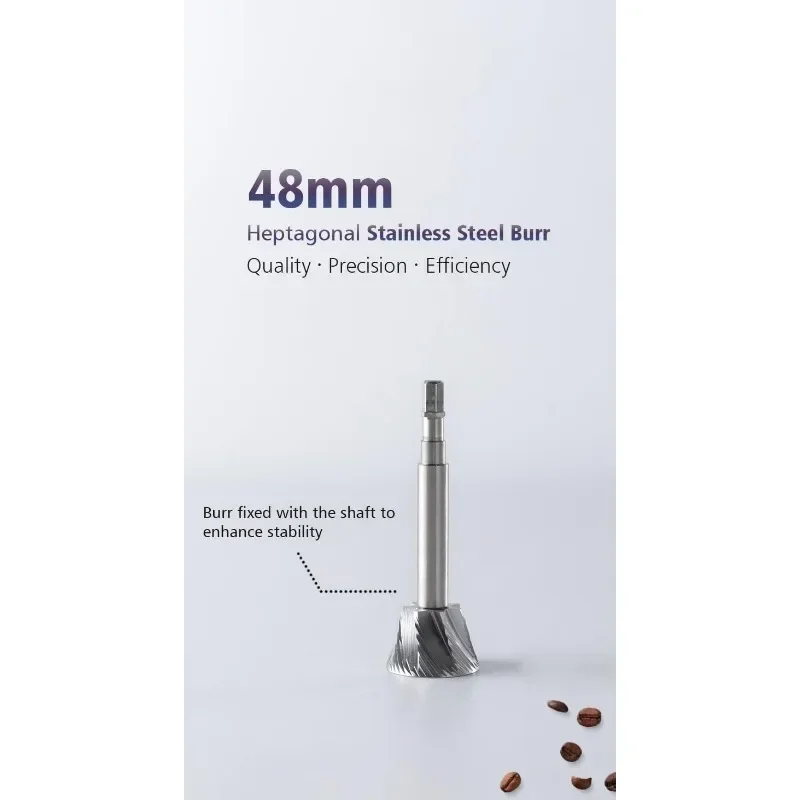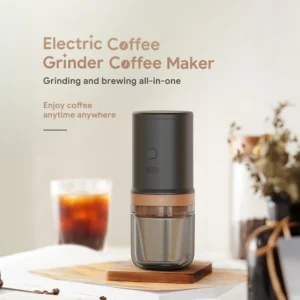Why the AeroPress Excels as a Travel Coffee Companion
The AeroPress has earned its reputation as the ultimate travel brewing companion for coffee lovers who refuse to compromise on quality while away from home. This remarkable brewing device combines lightweight portability (weighing just 8 ounces) with nearly indestructible durability, making it the perfect travel partner for any coffee enthusiast.
What truly sets the AeroPress apart is its trifecta of travel-friendly qualities: its compact design fits easily into a backpack or suitcase, its sturdy construction can withstand the rigors of travel, and cleanup requires just seconds – simply push out the used coffee puck and rinse. Whether you’re camping in the mountains or staying in a hotel, this versatile brewer delivers exceptional coffee in minimal space.
The AeroPress also offers incredible brewing versatility, allowing you to create everything from concentrated espresso-like shots to smooth, clean coffee similar to pour-over – all from a device that takes up less space than a water bottle. However, achieving this exceptional quality while traveling hinges on one crucial variable: getting your grind size right.
Understanding the relationship between precision grind settings and brewing quality becomes even more important when you’re on the go, facing inconsistent water quality, changing elevations, and limited equipment. The key to consistently excellent coffee lies in mastering how to adapt your grind to these varying conditions.
For travelers serious about their coffee experience, pairing your AeroPress with a quality travel coffee grinder ensures you’ll never be at the mercy of pre-ground coffee again. Let’s explore how to achieve the perfect grind for AeroPress brewing anywhere your adventures take you.
Understanding Coffee Grind Size Fundamentals for Travel Brewing
At its core, brewing coffee is about extraction – the process where hot water dissolves compounds from ground coffee. Grind size directly controls how quickly this extraction happens. Think of it this way: smaller particles have more surface area exposed to water, leading to faster extraction, while larger particles extract more slowly.
For AeroPress brewing, this relationship becomes particularly important. With its shorter brew times and gentle pressure system, the AeroPress requires a specific grind range to achieve optimal flavor. Too fine a grind can create excessive resistance and over-extracted, bitter coffee. Too coarse, and you’ll end up with weak, under-extracted coffee lacking proper flavor development.
When traveling, identifying the right grind size becomes trickier without specialized equipment. Here’s a simple visual and tactile reference guide:
- Coarse grind: Resembles kosher salt or rough sea salt – too coarse for standard AeroPress brewing
- Medium-coarse grind: Similar to regular sand – workable but typically leads to under-extraction
- Medium grind: Like granulated sugar – good for longer immersion AeroPress recipes
- Medium-fine grind: Resembles table salt – ideal starting point for most AeroPress brewing
- Fine grind: Similar to fine sand or slightly finer than table salt – works well for shorter brew methods
- Extra fine grind: Like powdered sugar – typically too fine, creating excessive resistance
Travel conditions introduce additional variables that affect your grind choice. Higher elevations may require slightly coarser grinds due to lower boiling temperatures. Hotel water, with varying mineral content, might extract differently than your water at home. Even ambient temperature can influence how your coffee extracts.
Understanding these fundamental principles of various grind sizes provides the foundation for adapting your brewing approach while traveling. With this knowledge, you can make informed adjustments to consistently brew excellent coffee, regardless of where your journey takes you.
The Ideal AeroPress Grind Setting for Travelers: Finding Your Sweet Spot
For travelers seeking consistently excellent AeroPress coffee, a medium-fine grind serves as the ideal starting point. This versatile setting – similar to table salt in texture – provides the perfect balance of extraction speed, flavor development, and pressure resistance for most AeroPress brewing methods.
When assessing your grind by feel, the medium-fine texture should be slightly gritty between your fingers but not powdery. Visually, the particles should be clearly distinguishable but significantly smaller than granulated sugar. This baseline setting works remarkably well across various travel conditions because it:
- Extracts efficiently within the typical 1-2 minute AeroPress brew time
- Creates appropriate resistance during plunging without excessive force
- Allows for flavor clarity while maintaining satisfying body
- Minimizes the risk of channeling (water finding paths of least resistance)
- Works well with both standard and inverted brewing methods
However, bean variables require consideration while traveling. Here’s how to adapt:
- For light roasts: These dense beans extract more slowly, so adjust slightly finer than medium-fine to maximize extraction of the bright, complex flavors.
- For dark roasts: These more porous beans extract more readily, so a slightly coarser grind prevents over-extraction and bitterness.
- For aged beans: If using coffee that’s not freshly roasted (common when traveling), a slightly finer grind compensates for diminished aromatics.
The brewing method also influences your ideal grind size. The inverted method, with its longer immersion time, can benefit from a slightly coarser grind, while the standard method may require a slightly finer grind to account for the shorter contact time.
Finding your ideal grind while traveling requires adaptability. The key is making incremental adjustments based on taste and brew resistance. A quality manual coffee grinder for espresso provides the precise control needed for these adjustments, allowing you to dial in the perfect setting regardless of your location.
Portable Coffee Grinders: Essential Tools for Fresh Travel Brewing
Fresh grinding is arguably the single most impactful factor in brewing exceptional coffee while traveling. Pre-ground coffee begins losing aromatic compounds within minutes of grinding, while whole beans maintain their flavor potential for weeks. This difference becomes especially noticeable in the clean, pressure-brewed cup that the AeroPress produces.
Manual hand grinders represent the ideal travel companion for several compelling reasons:
- No electricity required: Brew anywhere, from remote camping sites to hotel rooms
- Compact design: Many quality hand grinders occupy no more space than a water bottle
- Lightweight construction: Typically weighing under a pound, they add minimal weight to your luggage
- Durability: Quality models withstand the bumps and drops inevitable during travel
- Precision control: Good hand grinders often provide more consistent results than budget electric models
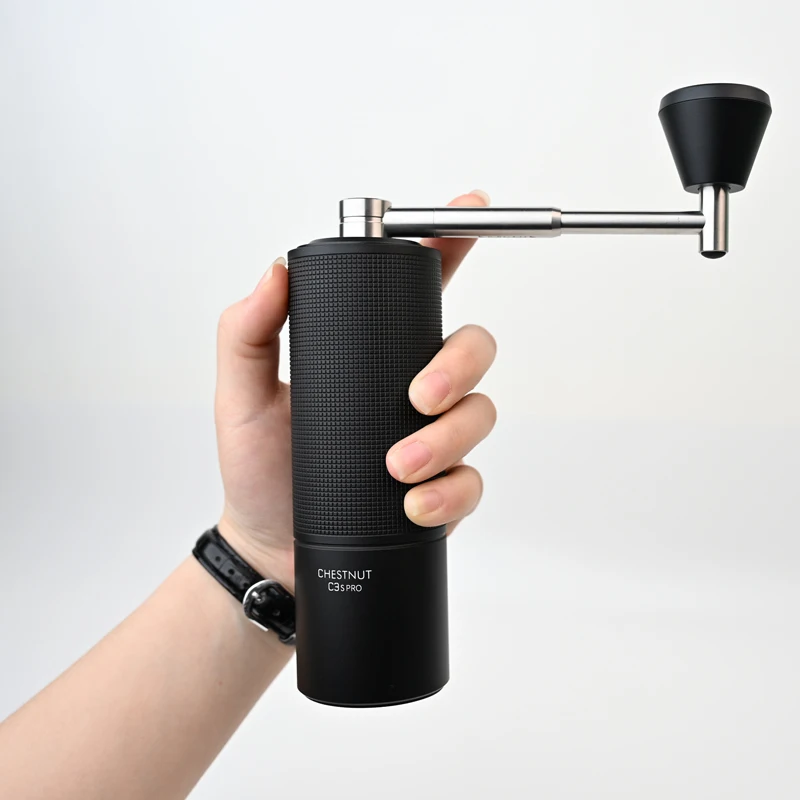
When selecting a travel grinder, focus on these critical features:
- Burr quality: Ceramic burrs provide good performance and never rust, while steel burrs offer superior precision and durability
- Adjustment mechanism: Look for defined click settings that won’t drift during travel
- Grind consistency: Uniform particle size dramatically improves extraction quality
- Build materials: Lightweight aluminum or reinforced plastic bodies save weight without sacrificing performance
- Ergonomics: Comfortable grinding mechanics prevent hand fatigue
- Capacity: Ability to hold enough beans for at least two servings (typically 30-40g)
Understanding the differences between manual and automatic grinder settings becomes particularly relevant when traveling. While electric grinders may offer convenience at home, manual grinders provide more reliable performance in variable travel conditions.
To achieve consistent results with portable grinders:
- Use a steady grinding motion rather than rapid cranking
- Hold the grinder vertically when possible for even particle distribution
- Count the number of beans used and the time spent grinding for repeatability
- Check your grind visually before brewing, as settings may shift during travel
For travelers seeking the perfect balance of portability and performance, a quality portable coffee grinder represents an essential investment. The difference in flavor between freshly ground coffee and pre-ground alternatives becomes even more pronounced under variable travel conditions.
Adjusting Your Grind While Traveling: Troubleshooting Common Issues
Even with the perfect grinder, travel brewing introduces variables that require on-the-fly adjustments. Knowing how to identify and solve common extraction issues will dramatically improve your travel coffee experience.
Physical Indicators Your Grind Needs Adjustment
- Excessive resistance when pressing: If plunging requires significant force, your grind is likely too fine, creating over-extraction and potential bitterness.
- Too-quick plunging with no resistance: If the plunger drops easily, your grind is probably too coarse, resulting in under-extraction and weak flavor.
- Water bypassing coffee rather than flowing through it: This “channeling” occurs with overly fine grinds, creating uneven extraction.
Taste-Based Troubleshooting
- Under-extraction symptoms: Sour, sharp, tart, lacks sweetness, disappointing finish, watery body
Solution: Grind finer, increase water temperature, extend brew time, or stir more vigorously
Over-extraction symptoms: Bitter, harsh, astringent, hollow flavor, lingering unpleasant finish
- Solution: Grind coarser, slightly lower water temperature, reduce brew time, or use less agitation
Adapting to Travel Variables
- Hard water (common in many hotels): Tends to extract more efficiently, so use a slightly coarser grind
- Soft water: May under-extract, requiring a slightly finer grind
- High altitude: Water boils at lower temperatures, requiring a finer grind to compensate
- Limited hot water access: If using water below optimal temperature, a finer grind helps increase extraction
When your grinder options are limited, adjust other variables to compensate:
- Modify brew time (longer for coarser grinds, shorter for finer ones)
- Adjust the coffee-to-water ratio (stronger ratios can help compensate for coarser grinds)
- Change your agitation technique (more stirring accelerates extraction)
Following this systematic approach to travel grind adjustments allows you to adapt to changing conditions while maintaining excellent coffee quality. Remember that each adjustment should be incremental – dramatic changes can overcorrect the problem and create new issues.
AeroPress Travel Brewing: Practical Recipes Optimized for Grind Variables
With your grind fundamentals established, these practical recipes provide reliable starting points for exceptional AeroPress coffee anywhere. Each recipe can be fine-tuned based on your specific travel conditions and equipment.
Standard Travel AeroPress Recipe (Medium-Fine Grind)
Ingredients:
* 17g coffee (medium-fine grind – table salt texture)
* 250ml water (just off boil – approximately 205°F/96°C)
Equipment:
* AeroPress with paper filter
* Grinder set to medium-fine
Method:
1. Rinse paper filter and attach to AeroPress
2. Add ground coffee to chamber
3. Start timer and add 50ml water for blooming
4. Gently stir 5-8 times to ensure even saturation
5. At 30 seconds, add remaining 200ml water
6. Secure cap with pre-rinsed filter
7. At 1:15, flip AeroPress onto cup and begin pressing
8. Press gently, completing plunge by 1:45
9. Enjoy immediately
Inverted Method for More Control (Medium Grind)
When hotel water quality varies or you want more control over brew time, the inverted method with a slightly coarser grind provides excellent results:
Ingredients:
* 18g coffee (medium grind – between table salt and sugar texture)
* 240ml water (195-205°F/90-96°C)
Method:
1. Assemble AeroPress in inverted position (plunger inserted slightly into chamber, sitting on plunger end)
2. Add coffee grounds
3. Start timer and add 60ml water
4. Stir gently for 10 seconds
5. Add remaining water
6. At 1:30, attach rinsed filter cap
7. At 1:45, carefully flip onto cup and press
8. Complete pressing by 2:15
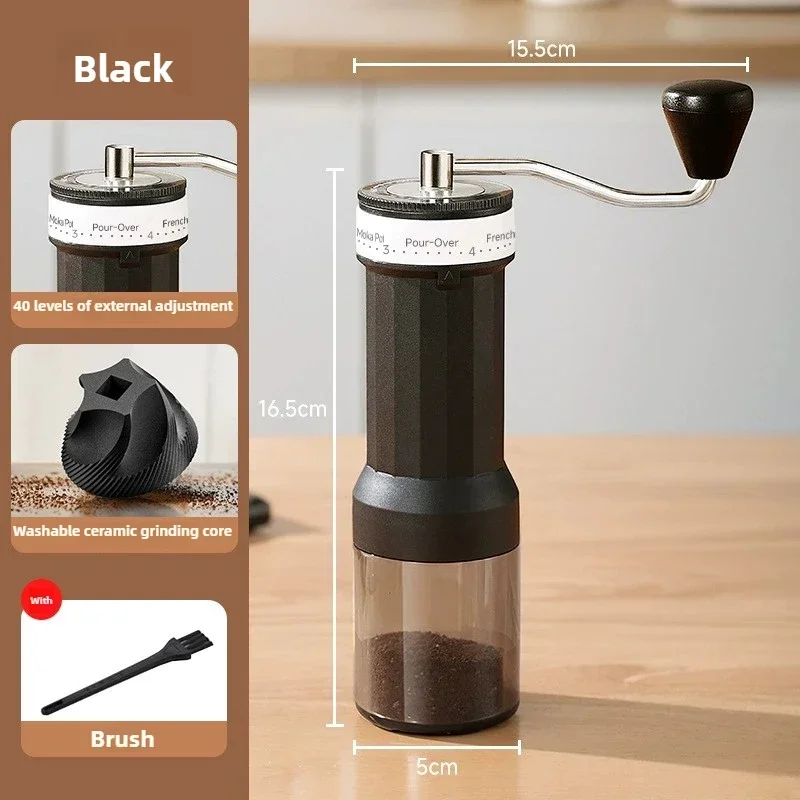
Working with Pre-Ground Coffee
When freshly grinding isn’t possible, this modified approach helps compensate:
- For typical pre-ground coffee (often medium grind):
- Use slightly cooler water (190°F/88°C)
- Extend brew time by 30 seconds
- Stir more gently to prevent over-extraction
- Consider using two paper filters to slow flow rate
Understanding precision grind settings helps you adapt these recipes to variable conditions. The key is viewing these recipes as starting points, making incremental adjustments based on taste and extraction quality.
Fine Adjustment Hand Grinder, Precision Manual Grinder, Travel Coffee Grinder
Price range: $185.11 through $494.63 Select options This product has multiple variants. The options may be chosen on the product pageHand Burr Grinder, Hand Crank Coffee Grinder, Manual Espresso Grinder, Portable Coffee Grinder
Price range: $262.72 through $300.22 Select options This product has multiple variants. The options may be chosen on the product pageManual Burr Mill, Manual Coffee Grinder Stainless Steel, Manual Coffee Mill Grinder, Mechanical Coffee Grinder
Price range: $127.26 through $130.32 Select options This product has multiple variants. The options may be chosen on the product pageHand Crank Coffee Grinder, Manual Burr Mill, Manual Coffee Bean Grinder
Price range: $2,053.84 through $2,918.42 Select options This product has multiple variants. The options may be chosen on the product pageHandheld Burr Grinder, Manual Coffee Mill Grinder, Travel Coffee Grinder
$191.45 Select options This product has multiple variants. The options may be chosen on the product page
Advanced Travel Grind Considerations for Coffee Enthusiasts
For coffee enthusiasts seeking to elevate their travel brewing, exploring the extremes of the grind spectrum opens new flavor possibilities. While a medium-fine grind serves as a reliable baseline, intentional deviations can create distinctive experiences:
- Ultra-fine grind experiment: Using a setting just shy of espresso fineness creates intense concentration and body. This approach requires:
- Very gentle pressure during plunging
- Shorter brew time (45-60 seconds)
- Lower water temperature (185-190°F/85-88°C)
Results in a more espresso-like concentration with pronounced sweetness
Coarser grind exploration: Moving toward medium-coarse creates a cleaner, tea-like clarity. This approach benefits from:
- Extended steep time (2:30-3:00)
- Higher water temperature (205°F/96°C)
- More agitation during brewing
- Results in highlighting bright, acidic notes and floral aromatics
Your choice of filter dramatically impacts optimal grind settings. Metal filters allow more oils and fine particles to pass through, benefiting from a slightly coarser grind to prevent sediment. Paper filters create cleaner cups and work better with slightly finer grinds that maximize extraction without clogging.
When traveling with less-than-ideal equipment, these techniques improve grind consistency:
- Double-sift your grounds through a fine mesh (like a tea strainer) to remove outlier particles
- Use the “tap method” – gently tapping your grinder on a hard surface during grinding helps particles settle more uniformly
- Grind in smaller batches for more consistent results
- Time your grinding precisely for better repeatability
Different water sources require different approaches. Hard mineral-heavy water extracts more efficiently, demanding slightly coarser grinds. Soft or filtered water may benefit from finer grinds to maximize extraction. The quality manual burr mills provide the precision necessary for these subtle adjustments, allowing you to adapt to any water source you encounter.
Essential Maintenance for Your AeroPress and Grinder on the Go
Maintaining your coffee equipment while traveling ensures consistent performance and extends the lifespan of your gear. These efficient maintenance routines take minimal time while preventing common travel-related issues:
Quick AeroPress Cleaning Protocol:
* Immediately after brewing, remove the cap and push the plunger to eject the coffee puck
* Rinse all components with clean water (hot if available)
* For deeper cleaning every few days, separate all components and rinse thoroughly
* Allow to air dry whenever possible rather than sealing while damp
* If soap is unavailable, rinsing with hot water is sufficient for short trips
Portable Grinder Maintenance:
* After each use, brush visible coffee particles from burrs and catch bin
* Weekly (or after grinding 100g), remove any accessible burr components for thorough cleaning
* Use a clean, dry brush rather than water whenever possible
* If grinding feels inconsistent or difficult, check for loose adjustment settings
* Store with the adjustment set to fully open to reduce stress on components
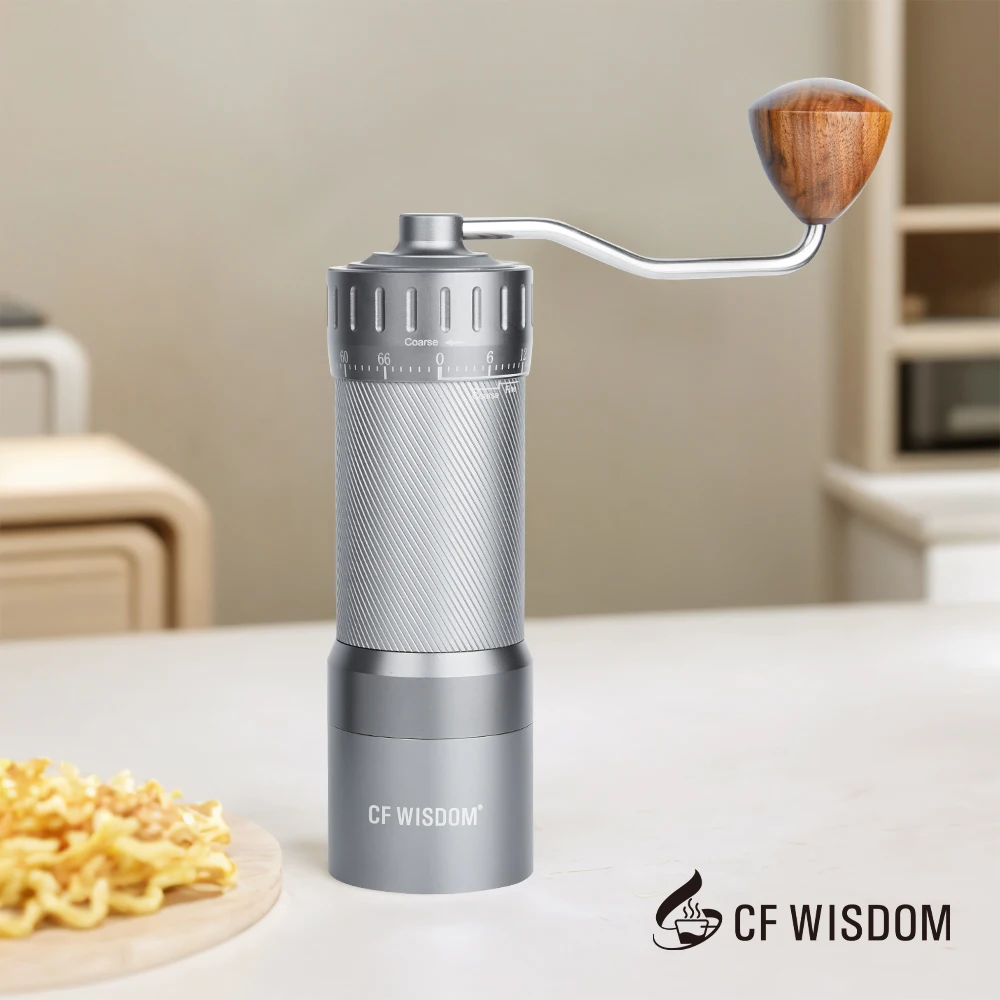
Storage Best Practices:
* Keep coffee beans in an airtight container away from heat, light, and moisture
* Store your AeroPress with plunger partially inserted rather than fully compressed to preserve the seal
* Keep your grinder in a protective case or wrap in a clean shirt to prevent damage
* Never store a damp AeroPress assembled, as this can promote mold growth
Warning Signs Requiring Attention:
* Increased grinding effort or inconsistent particles indicates burr issues
* Difficulty plunging suggests rubber seal damage on the AeroPress
* Unusual tastes may indicate mold growth from improper storage
For emergency troubleshooting, a small multi-tool can help disassemble your handheld coffee grinder for field repairs. Most quality travel grinders can be disassembled with basic tools, allowing you to clear jams or reset misaligned components while on the go.
Frequently Asked Questions About AeroPress Travel Grinding
Q: How can I tell if my grind size is correct without specialized tools?
A: Compare your ground coffee to common household items: ideal AeroPress grind should resemble table salt. Additionally, brewing should take moderate pressure to plunge (10-20 seconds of gentle pressing). Too much resistance indicates too fine a grind; too little suggests it’s too coarse.
Q: Can I use an espresso grind in my AeroPress while traveling?
A: Yes, but with modifications. Espresso grind works well with shorter brew times (30-45 seconds), cooler water, and very gentle pressure. This produces a concentrated, rich cup, but requires careful technique to avoid excessive resistance or bitterness.
Q: How do I translate grind settings between different hand grinders?
A: Unfortunately, grind settings aren’t standardized between brands. Start by finding the point where burrs just begin to touch (zero point), then count clicks or turns from there. Most AeroPress brewing works best between 8-12 clicks from zero on popular travel grinders.
Q: My coffee tastes inconsistent despite using the same grind setting. Why?
A: Travel introduces many variables beyond grind size. Water mineral content, elevation, bean freshness, and temperature fluctuations all affect extraction. Try controlling as many variables as possible, particularly water temperature and brew time.
Q: Is it worth bringing a grinder for a short trip?
A: Even for weekend trips, hand grinders for travel brewing significantly improve coffee quality. The freshness difference is most noticeable with high-quality beans and clean brewing methods like the AeroPress. For trips under 3 days, pre-grinding immediately before departure is a reasonable compromise.
Additional Considerations for Different Travel Scenarios
Different travel contexts present unique challenges for AeroPress brewing. Adapting your approach to specific scenarios ensures great coffee regardless of circumstances:
High-Altitude Brewing:
At elevations above 4,000 feet, water boils at lower temperatures, reducing extraction efficiency. Compensate by grinding 1-2 settings finer than your standard setting and extending brew time by 15-30 seconds. This adjustment ensures proper extraction despite the cooler brewing temperature.
Hotel Room Brewing:
Hotel rooms present challenges like inconsistent water quality and limited space. Use bottled water when tap water tastes heavily chlorinated. To minimize mess, brew directly over the bathroom sink and rinse equipment immediately after use. A small travel towel dedicated to coffee equipment saves paper waste.
Camping and Outdoor Adventures:
When weight and space are critical, pre-measuring coffee into individual paper filters or small bags eliminates the need for scales. For multi-day trips, slightly coarser grinds are more forgiving of field conditions. Consider the inverted method to prevent accidental spills on uneven surfaces.
International Travel:
When encountering unfamiliar coffee in foreign countries, start with a slightly coarser grind than usual, then adjust based on taste. If language barriers prevent communicating grind size to local shops, visual references on your phone help convey the desired texture.
Time-Constrained Situations:
For early morning departures or quick brewing needs, prepare by setting up your equipment the night before. Pre-heat your mug with hot water while grinding to maximize temperature stability and extraction efficiency.
Perfect Your AeroPress Travel Brewing Technique
Mastering the relationship between grind size and brewing variables forms the foundation of exceptional travel coffee. While the perfect medium-fine grind creates a reliable starting point, the true art lies in making thoughtful adjustments based on your specific conditions and taste preferences.
Remember that coffee brewing is both science and personal expression. The recommendations throughout this guide provide a framework, but your palate remains the ultimate judge. Don’t hesitate to experiment with different grind sizes, noting how each adjustment affects body, acidity, sweetness, and overall balance in your cup.
What makes AeroPress travel brewing particularly rewarding is how this compact system transforms ordinary moments into extraordinary coffee experiences. Whether you’re watching sunrise from a mountain overlook or preparing for a business meeting in a hotel room, the ritual of grinding fresh beans and crafting your perfect cup connects you to the moment.
As you continue your coffee journey, focusing on grind quality will consistently yield the greatest improvements in your brewing results. With practice, you’ll develop an intuitive understanding of how to adapt to any situation, ensuring that wherever your adventures take you, exceptional coffee will always be within reach.

